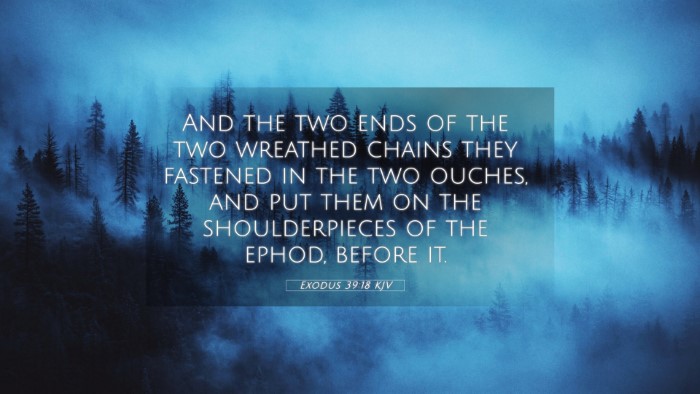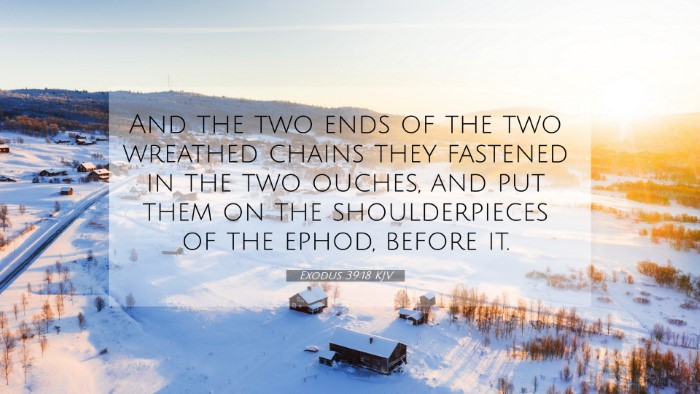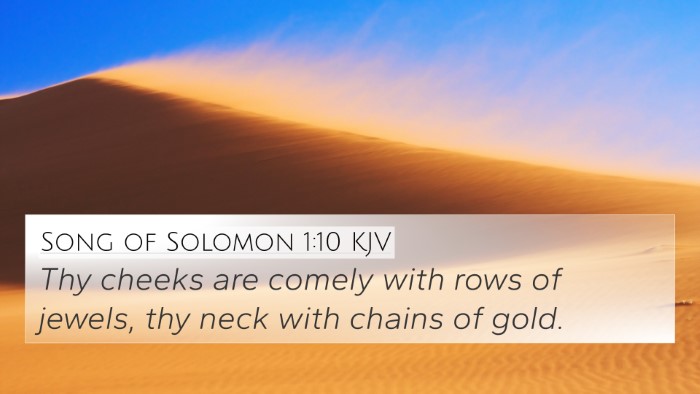Understanding Exodus 39:18
Exodus 39:18 states: "And the other two ends of the two wreathen chains thou shalt fasten in the two ouches, and put them on the shoulder pieces of the ephod before it." This verse is part of the detailed instructions regarding the garments of the high priest, specifically the ephod.
Meaning of Exodus 39:18
This verse describes the construction and assembly of the ephod, which is a pivotal garment worn by the high priest in the ancient Israelite religious practices. The ephod symbolizes the divine authority of the priest and his role as an intermediary between God and the people.
Insights from Commentaries
-
Matthew Henry's Commentary:
Henry emphasizes the significance of the ephod as a symbol of God's presence among His people. The meticulous details in the construction reflect God's order and the importance of holiness in worship.
-
Albert Barnes' Notes:
Barnes notes that the chains and ouches mentioned are crucial for securing the ephod, indicating the stability and strength required in the high priest's service. This functional aspect highlights God's desire for His servant's readiness to perform sacred duties.
-
Adam Clarke's Commentary:
Clarke points out the beautiful design and craftsmanship involved, which served not only aesthetic purposes but also to signify the high status of the priestly role. He elaborates on how each element serves a purpose in the greater context of Israel's worship.
Thematic Connections
Exodus 39:18 opens a window into broader themes found in the Bible that elucidate the nature of priesthood and God's covenant with His people. Several Scriptures connect to the themes found in this verse:
- Exodus 28:6-14 - Details of the ephod's design.
- Leviticus 8:7-8 - The consecration of Aaron and his sons as priests.
- Hebrews 5:1 - Discusses the high priest's role in offering gifts and sacrifices.
- 1 Peter 2:9 - The concept of believers as a royal priesthood under Christ.
- Revelation 1:6 - A declaration of the church's shared priestly status through Jesus.
- Matthew 26:63-64 - Jesus as the high priest in the new covenant.
- Hebrews 8:1-2 - Christ as the high priest in the heavenly sanctuary.
Cross-Referencing Biblical Texts
The importance of understanding Exodus 39:18 can be augmented through a systematic approach to cross-referencing. Here are some tools and methods for deeper Bible study:
- Bible Concordance: A valuable resource for finding verses related to specific words or themes.
- Bible Cross-Reference Guide: Offers connections between verses that enhance understanding.
- Cross-Reference Bible Study: A methodical approach to explore the relationship between verses.
- Bible Chain References: Follow thematic links through Scripture for comprehensive study.
- Comprehensive Bible Cross-Reference Materials: Utilize extensive resources for in-depth analysis.
Applications for Modern Believers
Understanding Exodus 39:18 and its contextual significance helps modern readers apply its principles in today's context. This can be a basis for reflecting on roles within the church, the nature of service, and one's personal relationship with God as a part of a larger community of believers.
Finding Cross-References
When seeking to identify connections between passages, consider:
- Using a concordance or digital Bible study tool for ease of access.
- Engaging in detailed studies of themes, such as priesthood or worship, across the books of the Bible.
- Formulating questions about how specific verses inform one another, inviting deeper exploration of Biblical texts.
Conclusion
Exodus 39:18 provides insight into God's design for His worship and the role of the priest. By exploring its meaning through the lens of public domain commentaries and utilizing tools for cross-referencing, believers can deepen their understanding of Scripture and enhance their spiritual journey.




